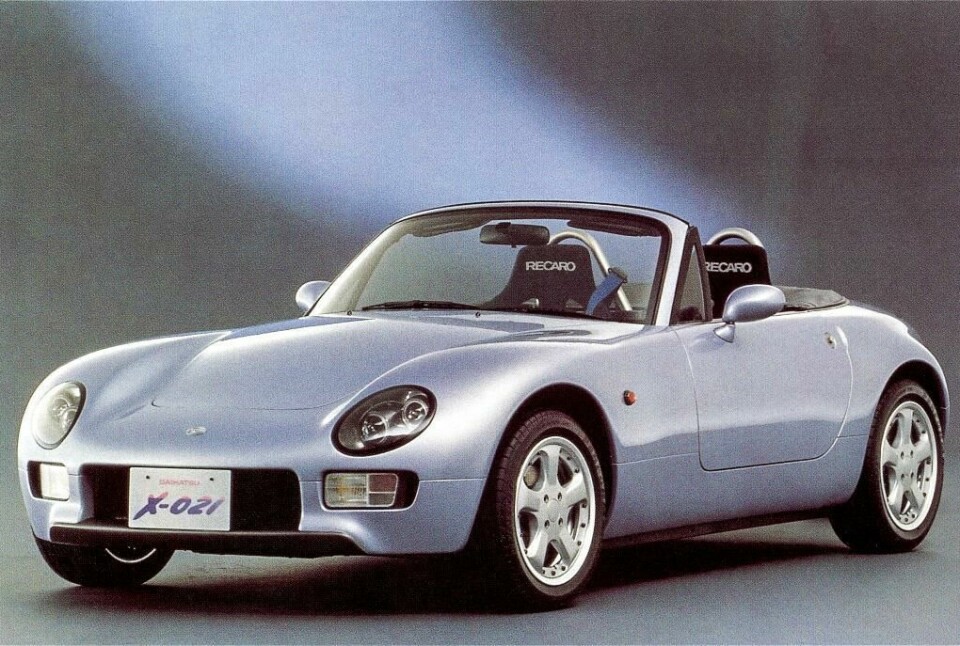
Concept Car of the Week: Daihatsu X-021 (1991)
Tiny rival to the Mazda MX-5 that was destined not to be
In the history of automotive design, there are inflection points – where a car changes the direction of design throughout the industry. One such time was the introduction of the Mazda MX-5 Miata in 1989. It captured the design and engineering essence of the roadster as no other car had in a generation. Additionally, the MX-5 had almost the entire roadster format to itself with only Alfa Romeo’s Spider produced in any volume. Naturally, any manufacturer that subsequently dared to enter into the roadster space found its offerings compared to the little Mazda.

Such was the challenge when Daihatsu introduced the X-021 roadster at the 1991 Frankfurt Motor Show. The “Daihatsu Miata” was how the car was reported in much of the press of the time. But those who closely reviewed the fully functional concept came away with very positive impressions.

The X-021 bore a resemblance to the MX-5, but details are critical at this scale, and the Daihatsu was different in some very important respects.
For starters, it was a smaller car – a full 350 mm shorter and some 200kg lighter than the MX-5 giving a power-to-weight ratio more in line with Porsche’s offerings than Mazda’s.
The design has a superficial resemblance to the MX-5’s, but on closer inspection the curves of the X-021 seem more taut, a bit more muscular. The overhangs were minimal, to say the least. The headlights were behind oval glass bezels that whispered “Jaguar E-Type”, rather than the pop-up lights of the MX-5. The headlights were also at terminus of the front fenders which, from the front three-quarter view, also reinforced the impression of a baby Jag.

The front fascia is simplicity itself - the oval lamps are located above turn signals, flanking a blacked-out grille opening. The hood dips down between the fenders to meet the top of the grille allowing excellent views of the road ahead.
The rear fascia was a similar study in simplicity. Brake lights, and turn signals were simple circles set into a simple rectangular fascia that emerges from the body between the rear wheel bulges. Below this fascia were a couple of bumper fins flanking the license plate. The Daihatsu badge was the only brightwork here, maintaining the purity of form shown throughout the car.

This purity of form was well displayed on the side elevation of the car with classic roadster proportions – long(ish) hood, set-back cockpit, and short deck. The X-021 also came with a removable fibreglass top that allowed it to become an all-weather coupe.
The interior was another essay in simplicity. A tiny cockpit – almost jet fighter-like in its compactness – with a three-spoke steering wheel, with an airbag was the focal point of the simple IP. Brushed aluminium featured prominently on the interior, complementing the back and blue colourway and the silver exterior. Recaro seats tightly cradled the driver and, combined with the short cockpit dimensions, meant that larger drivers need not apply.

An under-appreciated piece of the X-021 ensemble was the chassis that accompanied the finished car to Frankfurt. Prominently showcasing the racing suspension, gutsy little engine, and aluminium space frame, the chassis was meant to be a display of the engineering innards of the roadster. But as it turned out, it was a well-designed car in itself. It looked like a well-machined little hot rod – all engineering and fun, a high-tech go-kart. This chassis was subsequently finished out into a second, bright yellow X-021, which was shown at the 1992 Geneva motor show.

The X-021 was well received by the motoring press, but ultimately was destined to remain a concept. Daihatsu opted to develop a more retro-styled roadster called the Copen, which was introduced in 1999, and based on Daihatsu’s Kei car technologies. Still, when recalling the genesis of the Copen’s design, the X-021 was mentioned prominently. That’s not a bad legacy for the X-021, but it still leaves us wondering what might have been.




